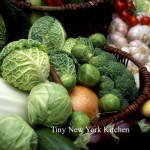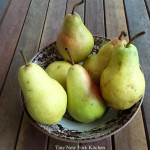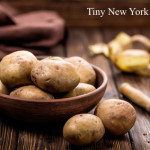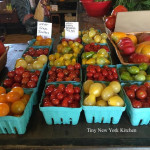Figs are truly fantastic! Dried figs are available all year round and many markets offer luxuriously sweet fresh figs throughout the year as well. Figs are a healthy and portable snack that is packed with nutrition.
Figs are rich in potassium, which helps control blood pressure. They also provide calcium, magnesium, iron, and copper. Because they’re rich in fiber, figs support digestive health and may be helpful for managing a healthy weight. Figs are among the most alkaline foods and help balance the body’s pH.
Fresh figs are highly perishable, so they should be eaten a day or two after you purchase them. Look for figs that have a rich, deep color and are plump and tender, but not mushy. Wash them under cool water and remove the stem. Add fresh or dried figs to oatmeal, salads, cheese, and baked goods.
“Work With What You Got!”
© Victoria Hart Glavin Tiny New York Kitchen © 2017 All Rights Reserved
Oranges and lemons were first brought to the Americas by Spanish explorers. Today the United States is among the world’s top citrus growers and consumers. To choose the best citrus select fruit that is heavy and not too soft. When selecting oranges don’t worry about the color, as it is not a good indicator of how tasty the orange will be. For lemons and limes the juiciest fruit gives a little when you gently squeeze them. I like to roll lemons and limes around on the counter with the palm of my hand to loosen up the juice before cutting into them.
Oranges, grapefruits, lemons, and limes are the most commonly found citrus fruits. Lemons, limes, and oranges come into season just when we need them the most, when days are short and the weather is cold. Rich in vitamin C and fiber, they add a zesty boost to almost any meal. During the winter months, look for other varieties, such as blood oranges, Key limes, and Meyer lemons, as well as grapefruit-like pomelos and tiny kumquats.
We need vitamin C to stay healthy and citrus fruit is a delicious way to add lots of this vital nutrient to your diet. Start the day with orange juice, add a squeeze of lemon to warm water later in the day, or pack grapefruit sections to enjoy as a snack at work or school.
Citrus stars in everything from sweet and savory dishes to non-food uses. Simmer slices of lemons, limes, and oranges in water to use as a natural air freshener, use lemon juice as a gentle alternative to laundry bleach, or combine lemon juice with olive oil to use as furniture polish.
Much of the citrus flavor is in the zest. Finely grate the peel and add to anything that needs a punch of citrus flavor. To get perfectly grated zest without bitter white pith, use a fine zester.
Make your own flavored salt by processing coarse salt, freshly ground black pepper, and citrus zest in a food processor. Add this mix to soups, stews, meats and pasta dishes.
Use a vegetable peeler to remove large strips of peel and add to hot tea, mulled wine, soups, and stews to add bold flavor.
To segment citrus like a pro cut a thin slice from either end of the fruit to make a base. Pare away the peel and white part of the rind. Cut into the fruit center between one section and the membrane. Cut along the other side, between section and membrane. Repeat.
www.tinynewyorkkitchen.com
“Work With What You Got!”
© Victoria Hart Glavin Tiny New York Kitchen © 2017 All Rights Reserved
The message is simple: Eat well to stay well. The good news is that you don’t need a graduate degree in nutrition to eat healthfully on a daily basis. What follows are some guidelines and information to help you make informed decisions about what you and your family should eat to maintain a balanced diet.
*Consume a variety of nutrient-dense foods and beverages within the basic food groups. Choose foods that limit your intake of saturated and trans fats, cholesterol, added sugars, salt, and alcohol.
*Engage in regular physical activity and reduce sedentary activities to promote health, psychological well-being, and a healthy body weight.
*Consume three or more 1 ounce equivalent servings of whole grains each day.
*Consume 3 cups of fat-free or low-fat milk or equivalent dairy products per day.
*Derive less than 10 percent of your calories from saturated fat and less than 300mg of cholesterol per day. Avoid trans fats.
*Keep your total fat intake between 20 and 35 percent of your calories, with most fats coming from polyunsaturated and monounsaturated sources, such as fish, nuts, and vegetable oils.
*Choose fiber-rich fruits, vegetables, and whole grains each day.
*Consume less than 2,300mg (about 1 teaspoon) of sodium each day.
*Women who choose to drink alcohol should limit themselves to one drink per day; men should limit themselves to no more than two drinks per day.
“Work With What You Got!”
© Victoria Hart Glavin Tiny New York Kitchen © 2017 All Rights Reserved
Making precise slices of softer, smaller foods in a snap, literally, with this tool designed to hold slippery, hard-cooked eggs in its cradle as the wires cut through. Cleanup is just as speedy – use a kitchen brush and warm, soapy water.
It can quick slice soft fruits and vegetables such as peeled kiwis, hulled strawberries, white or cremini mushrooms, and pitted olives.
Create perfect rounds from soft cheeses, like fresh mozzarella balls and goat cheese.
Make even pats from a stick of butter.
Be creative and try using an egg slicer on soft foods that you’re preparing. The possibilities are endless.
“Work With What You Got!”
© Victoria Hart Glavin Tiny New York Kitchen © 2017 All Rights Reserved
Pears
Season: June to October, but can be cold-stored until spring.
Pears are one of the few fruits that should be picked when under ripe. Buy hard pears a few days before you need them, and let them ripen at room temperature until they have a slight yield when given a gentle squeeze.
To core a pear, cut the pear in half lengthwise, and then scoop out the hard portions with a melon baller. Pear flesh (like apple) oxidizes when exposed to air, so rub the cut areas with lemon juice or white wine to keep them from turning brown.
“Work With What You Got!”
© Victoria Hart Glavin Tiny New York Kitchen © 2016 All Rights Reserved
5 Ways To Use A Vegetable Peeler
The humble vegetable peeler has hidden talents.
Easily Peel Fruit: To peel soft fruits and vegetables, like tomatoes and peaches, you usually have to briefly dunk them into boiling water. Using a good vegetable peeler is so much easier and faster. Look for peelers with serrated blades for the best results and select not-too-ripe fruit.
Shaved Cheese: Give salads, pastas and roasted vegetables a restaurant-style finish by garnishing with generous amounts of shaved Parmesan or pecorino romano cheese.
Vegetable Pasta: Shave long strips of zucchini, carrots (even sweet potatoes and squash) to transform them into pasta substitutes. Serve raw or briefly steamed with your favorite sauce, or toss with a vinaigrette for a fresh and nutritious salad.
Spreadable Butter: Is there anything worse than trying to butter toast or bread with rock hard butter straight from the fridge? Use a vegetable peeler to scrape off thin and perfectly spreadable butter ribbons.
Chocolate Curls: Peel the edge of a slightly softened chunk of chocolate to create curls, or the flat surface of very cold chocolate to make shavings. Keep your creations in the freezer and use to garnish cakes, pies, puddings and seasonal fruit.
www.tinynewyorkkitchen.com
“Work With What You Got!”
© Victoria Hart Glavin Tiny New York Kitchen © 2016 All Rights Reserved
It’s finally the most perfect weather ever and it’s nice to see the fruit and vegetable vendors set up on the street corners. I say hello to this friendly vendor in the mornings when I’m on my way to the gym.
Homemade Fruit & Vegetable Wash
I’ve made the mistake of buying premade produce wash and have spent way too much money to find out that many of them don’t really work that well. It’s easy to make your own and you’ll save plenty of money as well. You’ll just need to invest in a decent spray bottle.
INGREDIENTS
1 Cup Water
1/4 Cup White Vinegar
3 Tablespoons Lemon Juice
Pour into spray bottle and use by spraying produce, wipe thoroughly, and rinse. It’s that easy!
Makes About 1 1/4 Cups
“Work With What You Got!”
© Victoria Hart Glavin Tiny New York Kitchen © 2016 All Rights Reserved
Ways To Make The Most Of Seasonal Citrus
Zest It
Add zip to baked goods, stir-fries or stews. Make citrus salt!
Juice It
Lemons juice helps keep sliced fruits and root vegetables from turning brown. Finish savory dishes with a squeeze of lemon juice to enhance the flavors.
Freeze It
Freeze citrus juice or zest until you’re ready to use it.
Dry It
Bake peels on the lowest possible heat until dry, but still pliable. Use to flavor black tea, roasted chicken or braised meats.
Candy It
Garnish desserts and cocktails with candied peels or enjoy them as a sweet snack.
“Work With What You Got!”
© Victoria Hart Glavin Tiny New York Kitchen © 2016 All Rights Reserved















